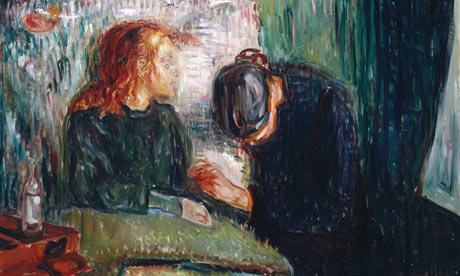We love anniversaries. This year is being pushed as the centenary of modernism, since The Waste Land and Ulysses were both published in 1922. But Edvard Munch had TS Eliot and James Joyce beat. In 1892, Munch painted the first modernist masterpiece of the city, anticipating their radical visions of urban life by a full three decades. Now that masterpiece, Evening on Karl Johan, has come to Britain as part of a precious loan of incendiary Munchs from a collection in Bergen, Norway.
These people really need to work from home. They come towards us at the close of day, their faces harrowed by the misery of the office or factory. They are ghoulish grey cartoons of loneliness and sadness lit by yellow glowing windows. A woman stares out with white circles for eyes, her pupils shrunk to dots, while a man in a funereal top hat has a shrunken skull-like face, as if modern life has reduced him to one of the walking dead. In fact, they are all workaday zombies, their bodies stunted, their pace robotic, approaching in a single mummified mass.
This is the very alienation Eliot would put into words 30 years later: “A crowd flowed over London Bridge, so many, / I had not thought death had undone so many. / Sighs, short and infrequent, were exhaled, / And each man fixed his eyes before his feet.” Evening on Karl Johan prophesies the 20th-century city of lonely crowds trudging hopelessly between nowhere and nothing.
If being first means being the best, Munch deserves the title of the first true modernist, making this the movement’s 130th anniversary rather than its 100th. But that is just one way to judge art. What marks out Munch is the authenticity of the pain. Raw as Evening on Karl Johan is, it’s eclipsed by the painting next to it.
By the Deathbed portrays people standing over a child’s motionless body. Their agony is so complete there is hardly anything left of them. The woman closest to us has a mask of whiteness, like a bandage, over her face, leaving just little patches of pink around her eyes. Her features have been destroyed by her loss. Another woman has already gone further, her face just a pale cartoon with dot-eyes. All we can see of the departed is a small thin form under the sheets with lank brown hair. But we see death in the mourners’ black-clad forms. It has entered every fibre of their being. Life has been stolen from them.
It was stolen from Munch as a child, too. This painting remembers the devastating loss of his favourite sister Sophie from tuberculosis, which had already killed his mother. Grief infected how he saw life. TS Eliot’s protagonist in The Love Song of J Alfred Prufrock admits he was “not Prince Hamlet” – but the young man in Munch’s painting Melancholy clearly resembles the tragic Scandinavian hero as he broods by the shore, his head resting on his hand in a medieval symbol of melancholia that is as old as the Lewis Chessmen. Munch’s creamy brown and violet sky above a dead purple sea lets you feel his mood for yourself.
That is why it is so special to see Munch’s paintings up close, as opposed to his prints. This show may be modestly scaled, with just 18 paintings, but that is a lot of Munch on canvas – and in this perfectly lit, perfectly spaced exhibition you can get not just an eyeful but a soulful of the ecstatic sorrow of his colours. Munch wallows gloriously in his pain. All that melancholy spills out in his luxurious feel for paint. Among the dark green woods in his huge 1894 canvas Woman in Three Stages is what looks like a big bloodstain: he has hurled red paint at the canvas to create this gash of horror. Or at least that’s what I’m assuming happened. Perhaps they should test to see if it’s blood.
As if the overpowering sense of grief wasn’t enough, Munch’s art unashamedly confesses to massive sexual hangups. There’s a young man to the right of this work, brooding beside three images of women: one is a dreamer by the shore, another walks wraith-like in the woods, and in the very middle stands a tall naked woman with her head cocked in sexual challenge. You’d think Munch’s male alter ego would be pleased but he looks wretched. And in Man and Woman, a naked man has his head lowered in despair as he helplessly sits facing his nude girlfriend. This bedroom scene is nothing if not unmanning. Munch clearly identifies with this male ego crushed into impotence by the woman’s nudity. How many artists have been this frank?
This exhibition shows how Munch leapt from lovely 1880s post-impressionist scenes – including a portrait of his sister Inger by a misty sea – to his intense, abstract fin de siècle images of unveiled emotion, so extreme it seems he is missing a skin. Self-Portrait in the Clinic, painted in 1909, shows why he could not go on like that. Munch’s most expressive period was bought at the expense of traumatic love affairs and alcoholism. In 1908, he had a breakdown and entered a “nerve clinic”. This painting shows him in recovery: at first sight it may seem a more formal work, with Munch adopting a respectable, serious pose, but then you realise he is actually painting himself trying on this pose, in the uneasy hope he can maintain it from now on. Yet his jacket is a frenzied pattern of purple daubs. Munch can’t forget what he saw when he looked into the bloodstained forest.
Edvard Munch: Masterpieces from Bergen is at the Courtauld Gallery, London, 27 May to 4 September.











